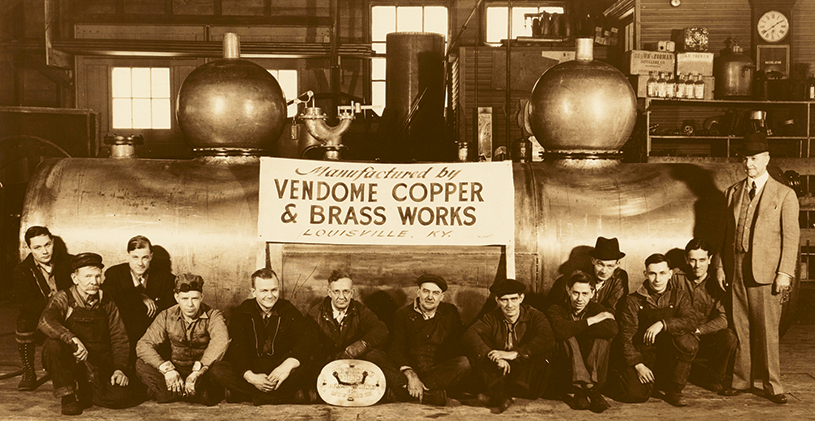
For one hundred plus years the Vendome Copper and Brass Works has been fabricating and supplying equipment to distilleries and other industries needing stills, cookers, vats and other metal apparatus. Vendome located throughout its history in downtown Louisville, Kentucky is a family owned business founded by W. Elmore Sherman, Sr. and now overseen by the fourth generation of Shermans.
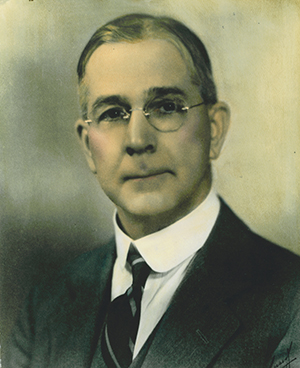
Vendome’s Antecedents
Before starting Vendome, Elmore Sherman had learned the distillery equipment fabrication trade at Hoffman, Ahlers & Co., which began business in Louisville in 1879. Hoffman, Ahlers was a successful Cincinnati copper company with a history going back to the 1830s. Beginning in 1872 Louis Hoffman and George Ahlers, specializing in distillery equipment, became its sole proprietors, and in 1879 they sent Hoffman’s son, Isaac A. Hoffman to establish the Louisville branch. Sherman, born in 1878, was first associated with the company in 1901 when he is listed in the city directory as its bookkeeper and when, on January 1 of that year, as one of six stockholders, he signed incorporation papers for the Louisville branch of the company. In the next few years, Sherman advanced in the company, being listed from 1903 to 1909 in the city directory as the company’s vice-president. During that period, George Ahlers, the president, was in Cincinnati suggesting that Sherman was in charge of the Louisville operation.

Hoffman, Ahlers was clearly successful, able to boast of its over eighty distillery customers in a handsome published catalogue of the distilling equipment it could supply to the trade. Its management history, however, was plagued by bad luck. Isaac A. Hoffman, the founder of the Louisville branch, died in 1899. When the company was incorporated in 1901, Isaac’s younger brother, Lewis, and George Ahlers, still living in Cincinnati, were the two largest shareholders. Lewis Hoffman must have had a falling out with the others because in about 1903 he established a short-lived competing company, Hoffman & Co. listed in the 1904 city directory and profiled in a book promoting Louisville industries. Interestingly, that company was located at 725-729 East Main Street, the premises that Vendome would later occupy. By 1905, all mention of the company and L. H. Hoffman in Louisville are gone.
On January 18, 1910 George Ahlers died, no doubt complicating the fortunes and future of the company still more. If not before, then certainly soon after, Sherman must have decided to start his own company, clearly taking some of the Hoffman, Ahlers customers with him. The first Vendome order book, still in the company’s possession, contains about 15 orders from the years 1900 to 1908, and then 20 for 1909 and 47 for 1910.

Early History of Vendome
The exact founding date of the business and the origin of its name are a bit murky, but certainly by 1910 and probably for a few years before, Vendome was in operation. The company still has a U. S. government stamp with the Vendome name on it for a still fabricated in October 1910. The company was listed in the Louisville city directory for the first time in 1911 and that same year it placed its first advertisement in The Wine and Spirit Bulletin, one of the leading distilling industry trade publications of the day. That year six coppersmiths in various U. S. cities advertised in the publication giving some idea of Vendome’s competition for the distilling business. The National Association of Storekeepers, Gaugers and Storekeeper-gaugers representing the government men who oversaw the running of the nation’s distilleries held its annual convention in Louisville in 1911 and Vendome also placed an ad in its substantial program.
On April 1, 1912 incorporation papers for Vendome Copper and Brass Works, Inc. were filed at the county courthouse. Later that year, on October 22nd, the company arranged for a three-year loan of $1500 and bought the property it had been occupying at 721-723 East Main Street, formerly 725-729 East Main Street. (The numbering on many Louisville streets changed in 1909.) Based on early order books still in the possession of Vendome, the company appears to have made a very successful start, doing business with many of the important Kentucky distilleries of the day as well as others around the country and a few as far away as Mexico, Panama and Burma. Certain customers such as Glenmore Distillery in Owensboro, Kentucky developed a special relationship with Vendome which provided that distillery with extensive amounts of equipment and repair services over the years. J. T. S. Brown & Sons and E.H. Taylor Jr. & Sons were other important early customers. In these first years Vendome also provided a significant amount of equipment to wood products companies manufacturing creosote and turpentine, both of which were obtained through a distillation process.
In 1914 Vendome devised a brilliant marketing tool to bring attention to its emerging business. The Wine and Spirit Bulletin reported enthusiastically about a miniature working still that was displayed by Vendome in Washington D. C. at the National Wholesale Liquor Dealers’ Association convention:
SEE THIS AT THE CONVENTION
There will be on display at the New Willard Hotel during the convention of the National Wholesale Liquor Dealers’ Association, at Washington, D.C., the most complete miniature distilling apparatus that we have ever seen. This is not a rough affair, but every part of the operation for making whisky can be followed absolutely, and each part of the machinery and apparatus is set up and finished, being constructed of the materials, whether wood, steel, or copper, just as they are in the finest complete distilleries, from the weighing of the grain, its passing through the hopper to the mash tub, then to the fermenters, the copper still, and the copper doubler until the operation is complete. There is a beer heater, all the necessary rakes and coils, flake stand, tall boxes for the low wines and whisky, and the slop tubs. This miniature distillery occupying a space of only 5×6 feet has been constructed by the Vendome Copper and Brass Works of Louisville, which will have it on exhibition in Washington.
To show the capacity of the Vendome Copper and Brass Works for doing all kinds of distillery work. It may be mentioned that at the same time this miniature distillery was being built, they have been at work on all the stills and other apparatus for a thousand-bushel plant which they are erecting in Algiers, Alabama. (Wine and Spirits Bulletin, Vol. XXVIII, May 1, 1914, 61)
The following year, the miniature distillery, in improved form, was exhibited at the Panama Pacific International Exposition in San Francisco where it won a bronze medal and a diploma. (Wine and Spirits Bulletin, Vol. XXIX, March 1, 1915, 61)
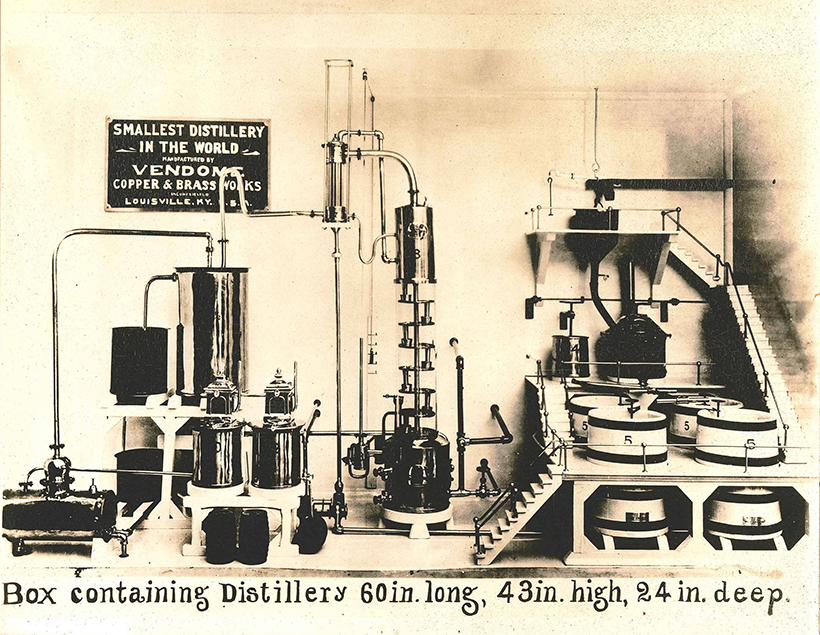
Prohibition Years
Vendome’s early success was quickly slowed to a crawl. The temperance forces in the United States had been gaining momentum for many years in their quest to prohibit all consumption of intoxicating beverages, and they were able to use World War I as the first excuse to shut down the industry. The Lever Food and Fuel Act passed by the dry forces in Congress in August 1917 prohibited the wartime use of grain for the production of beverage alcohol. In December of that year Congress voted to submit the Eighteenth Amendment calling for the prohibition of the manufacture, transportation and sale of intoxicating liquors to the states for ratification. On January 17, 1919 the amendment became law and one year later, as specified in the amendment, it took effect. Beginning in 1922 about thirty distilleries and warehouses, many of them in Kentucky, were designated as concentration warehouse sites where aging whiskey from shuttered distilleries across the country was collected to aid in its security. These distilleries were permitted to bottle whiskey on site for medicinal purposes. So with very few exceptions, from 1917 until the Twenty-first Amendment repealed Prohibition in 1933, distilleries and breweries were not able to use their distilling equipment to produce beverage alcohol. Vendome’s customer base in the distilling industry almost totally collapsed.
The company had a trickle of business throughout these years fabricating equipment for wood products companies and industrial alcohol plants but after 1923 it was no longer listed in the city directory. Elmore Sherman Sr. went into partnership with Gus Kleinsteuber as Kleinsteuber and Sherman to manufacture steam boilers with the business operating out of the shop at 721 East Main Street. In 1925 Sherman was hired to dismantle a shuttered Henderson, Kentucky distillery and re-erect it in Vancouver, British Columbia where he moved with his family for six months. He and several family members established the short-lived Southern Gasoline Pump Works to manufacture pumps in 1926 or 1927 but by 1931 he was listed in the city directory as working as a bookkeeper for the Nugent Sand Company. In May 1927 Sherman purchased a property at 153-157 North Shelby Street just north of Franklin Street where he eventually reestablished Vendome’s operations and from which the company operated until the present property on Franklin Street was purchased in the 1980s.
By the late 1920s attitudes toward Prohibition were beginning to change as the public tired of the rampant illegal drinking and general lawlessness associated with it. Beginning in late 1929 and continuing each year until Repeal as the supplies of aging whiskey available for medicinal use began to run low, the government permitted a handful of distilleries to produce limited amounts of new whiskey. Records document that in 1932 Vendome was commissioned to fabricate a “3,000 bushel, 24-hour complete distillery” for the Joseph S. Finch Distillery in Schenley, Pennsylvania owned by the Schenley Products Company. This was one of the very few with a production permit. Records also show that during 1933, Vendome did major work for about a dozen Kentucky distilleries that were rushing to revamp abandoned plants in anticipation of the end of Prohibition.
The Boom Years of the 1930s
The Twenty-first Amendment repealing the Eighteenth Amendment was sent by Congress to the states for ratification in February 1933 and Prohibition officially ended on December 5 when the amendment was ratified by the necessary thirty-sixth state. With the advent of Repeal, the distilling and beer industries mushroomed in size with over 126 distilleries alone opening between 1934 and 1937. Eventually, Vendome did business with over 100 different distilleries across the country. Orders ranged in size from an entire 9,000 bushel 24-hour distillery and massive 96” beer stills with their associated equipment to individual yeast jugs, fermenter coils and copper tanks. Reflecting the geographical distribution of the post-Repeal distilleries, the majority of the work was for Kentucky distilleries but the orders came from as far away as California, Massachusetts and Puerto Rico.
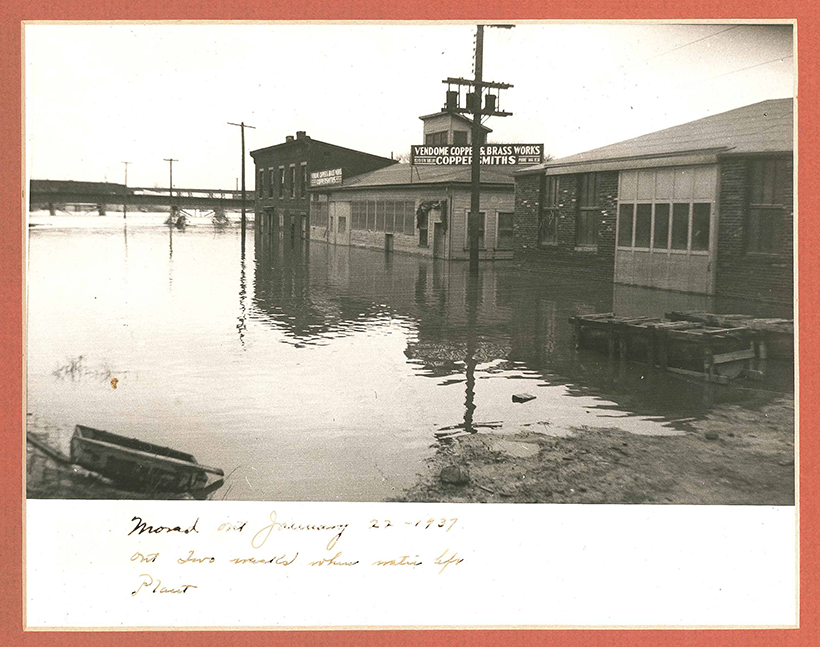
In January 1937, in the midst of one of Vendome’s busiest seasons, the company had to deal with massive Ohio River flooding which left much of Louisville under water. Vendome, located on low land near the river had water up to the rafters in its shop.
Adapting to the Market
Vendome has succeeded as a business long after its competition has virtually disappeared because it has been particularly adept at adapting to the market. The company has weathered a particularly volatile boom or bust business climate over the years by searching out customers in different industries, working with new materials as they were introduced, but at the same time, whenever possible, staying true to its original area of expertise – copper and brass equipment for the distilling industry.
After the boom years of the 1930s, the distilled spirits industry was once again challenged, this time by the coming of World War II. Because of the critical need for 190-proof industrial alcohol for the production of synthetic rubber, ammunition and other war material, by 1942 all distilleries were prohibited from producing beverage alcohol. Instead, where possible, they churned out massive quantities of ethyl alcohol for war time use. Vendome and other distillery suppliers had to adjust their product lineup to provide the necessary equipment.
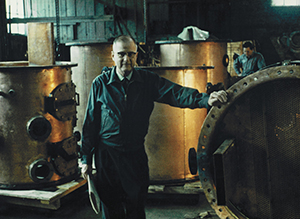
Beginning in the 1950s around the time Elmore Sherman, Sr. retired and was replaced as president by his son, Elmore Sherman, Jr., stainless steel, valued for its remarkable longevity, began to gain popularity as a new fabrication material. Whereas a copper still might have to be replaced every seven years or so, a stainless steel still is almost indestructible. So Vendome workers were trained to work with the new material while still retaining their expertise as coppersmiths, a rapidly disappearing group of highly skilled craftsmen.
As the tastes of the liquor-drinking public began to change dramatically from the 1960s through the 1980s from whiskey to gin, vodka and wine, the whiskey distilleries serviced by Vendome closed in large number. The company, by that time almost devoid of competitors, did a good business servicing its remaining customers but also did an excellent job finding new customers in the chemical, pharmaceutical, food, dairy and confectionery industries. By the 1970s Vendome, which had once primarily serviced Kentucky companies was doing 90% of its business out of state.
In 1974, when their father died, Thomas and Richard Sherman became the third generation of Shermans to lead the company, Thomas as President and Richard as Executive Vice President. Their assumption of leadership coincided with the rapid rise of the gasohol industry and a dramatic upswing in the demand for huge stills and associated equipment that could churn out gasohol on an industrial scale about ten times that required by the liquor industry.
Vendome moved around the corner to its present facilities at 729 East Franklin Street in 1980-1981 in part because of the need for more space and in part to reach higher ground where the danger of flooding was lessened somewhat. During the 1980s Vendome built the largest ever multi-column distilling system for fuel alcohol as well as the largest skid–mounted ethanol plant. Its customer base became worldwide.
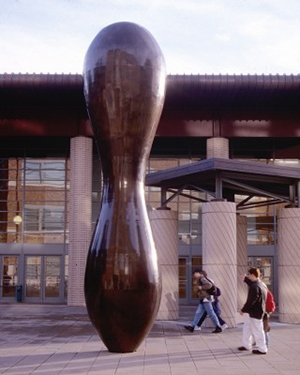
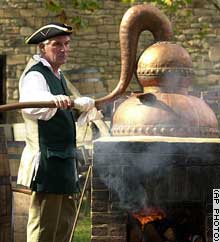
The acknowledged skill of the Vendome coppersmiths has also led to some really interesting and unusual commissions. In 1995, noted contemporary sculptor, Martin Puryear came to Vendome to work with its craftsmen on the fabrication of one of his pieces, a 23-foot copper sculpture entitled “Everything that Rises” which has been installed at the University of Washington. More in line with its primary focus on distilling equipment, are the replicas of 18th century pot stills that Vendome has fabricated for George Washington’s newly reconstructed distillery at Mount Vernon.
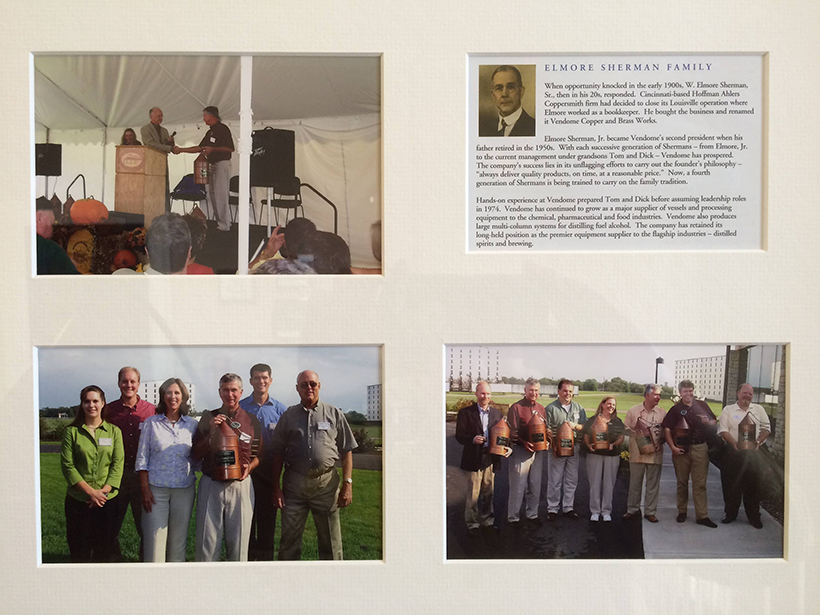
Present-Day Vendome
In 2005, The Elmore Sherman Family was inducted into the Kentucky Bourbon Hall of Fame. Supposedly the first non-distiller to be inducted.
The latest area of growth for Vendome has been in the production of specialty batch stills for the rapidly growing craft distilling industry. As early as the 1980s with the introduction of Makers Mark’s small batch bourbon and Blanton’s single-barrel bourbon the country slowly began to develop a taste for carefully crafted high-end whiskies. More recently the growing interest in local food sources has further fueled the industry’s growth. By 2005 there were about 50 micro-distilleries around the country and by 2020 the number had grown into the thousands. Vendome has worked with many of these new ventures to provide the necessary distilling equipment for their small scale operations.
The Vendome brand is known world round for first class custom, handcrafted products for both large and small makers as well as top-notch installation and service. Vendome equipment is used to make fine bourbon, rum, gin, vodka and other spirits. Vendome handcrafts batch and continuous distillation systems of all sizes, while custom designing and engineering each piece of equipment. The most common systems are designed for low to middle proof whiskey, rum, brandy, or single distillation of GNS, for gin and vodka. All of the systems are capable of producing 190 proof in multiple runs. In addition to stills, Vendome fabricates all related stainless steel and copper equipment including fermenters, cookers, condensers, coolers, whiskey tanks, bottling tanks, etc.
This unprecedented growth has not stopped. Today, Vendome has taken on more and more projects, leading to more and more satisfied customers. With Vendome’s products spanning over many different states and nations, Vendome has made stills for much of the distilling industry. This great success could not have been achieved without the hard-work and dedication from the 3rd and 4th generation Sherman family (pictured above). A few 5th generation Sherman’s are now becoming more familiar with Vendome’s operations. We look forward to what the future holds.
As Vendome moves into the 21st century, we will continue to use new materials, improved technology and the most practical production processes. And, we will continue to expand our horizons. That makes good business sense. But our dedication to quality and service will never change. That makes even better business sense.